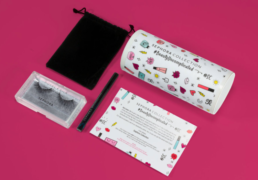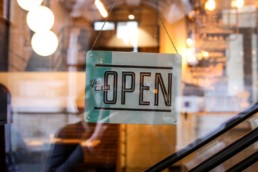Using Customer Loyalty Programs in Retail
retail
With the rise of big-box stores, online shopping giants, and same-day deliveries, the retail landscape has changed dramatically in a relatively short period of time. Consumers now have the freedom and flexibility to shop for virtually anything, any time of day, and enjoy affordable pricing, free shipping, and other perks that were once unheard of in the retail world. Because of this, the competition between retailers has never been more fierce. It is getting increasingly difficult to build and retain consumer loyalty with so many options available to shoppers nowadays. This seismic shift in how people purchase necessities and luxury items has caused a struggle among retailers to keep up with changing trends, as well as a constant search for a magic formula to stand out against competitors.

One of the most popular ways retailers maintain a healthy, thriving customer base is through loyalty programs. Many larger retailers offer customer loyalty programs that offer discounts and rewards earned through purchases. This strategy is effective not only by giving consumers an added incentive to do their business with a particular store, but also by ensuring that customers are likely to spend even more money when they return to use their reward points or earned discounts.
What Makes a Customer Loyalty Program Successful?
In order for a retail customer loyalty program to gain success among its target audience, it should meet the following requirements:
No Cost to Join
If a customer loyalty program is free, customers are far more likely to sign up than if there were a monthly or annual membership fee. While some retailers do offer rewards programs that cost money to subscribe, the free loyalty programs are almost universally more successful and popular than the ones that charge.
Keep in mind, however, that in order for a retailer to support a free rewards program, they must be able to cover the costs of the goods or services that are being given away or reduced in price. A prime example of this is the Starbucks rewards program, which is free to join and incredibly popular among its customers. Recently, customers could receive any menu item for free each time they earned 125 stars, at the rate of one star for each dollar spent in the store. Additionally, certain promotional events allowed customers to earn double or even triple stars on special days or at off-peak, “happy hour” times of the day. However, Starbucks recently had to change its reward redemption structure, as it became clear that customers were using their earned rewards stars toward big-ticket items, such as salads and sandwiches, rather than much-cheaper cups of coffee. The rewards program now operates on a tier system, but this has not seemed to hinder the success of the program.
User-Friendly
From the basic structure of the customer loyalty program to the ease and convenience with which points can be redeemed online, user experience is everything. When rolling out a new customer loyalty program, a retailer must make sure that both the desktop and mobile website or app supporting the earning and redemption of points is intuitive, convenient, and simple to use. Additionally, the structure of the program should be easy to understand and clearly laid out to avoid confusion and frustration among customers.
Not surprisingly, the Amazon Rewards Visa is one of the most user-friendly customer loyalty programs in existence. A digital native, Amazon has always led the pack when it comes to innovating online retail systems, and its rewards program is no exception. Though becoming a Rewards Visa member does require signing up and being approved for an Amazon credit card, after that, the reward points are as easy to redeem as they are to earn – both on and off the Amazon website. Even more importantly, members are able to access their point balance and view past transactions, earned reward points, and more on the website or mobile app, making it convenient, easy, and, as Amazon itself would say, “frustration-free.”
Great Incentives
As consumers everywhere can probably tell you, not all customer loyalty programs are created equal. Some retailers, for example, offer things like “store cash,” which can be redeemed only during select weeks and take a percentage off of a future purchase, rather than giving a customer anything for free. A good rewards program should offer a healthy balance of same-day discounts and the ability to redeem points toward free items. Some of our favorite incentives give the consumer a choice of special addition kits which make them feel rewarded while also introducing them to new products.
However, the ease with which customers can receive rewards is just as important as the incentives themselves. A number of customer loyalty programs tend to make people spend far too much before parting with even the smallest incentive on the tier. Movie theater rewards programs are a notorious offender, forcing rewards members to spend literal hundreds of dollars on ticket and concession purchases before even being granted a free small popcorn valued at five dollars!
No Expiration Date
A reward earned should be a reward kept. However, some retailers have structured their customer loyalty programs to include expiration dates for discounts and free items, even though a consumer has earned the points fair and square. The expiration date strategy is a purposeful one, designed to make customers come back sooner. However, it can be a major turnoff to earn enough points for a large reward, only to be told by a sales associate that those points expired one week ago! By structuring a customer loyalty program with no expiration dates, you are showing customers that you value them as people, not dollar signs.
Chick-Fil-A does a very nice job of handling the balance between when points are earned and when they are redeemed. Their loyalty program allows customers to spend their accumulated points either little by little or in one lump sum. A customer can use the Chick-Fil-A mobile app to easily keep track of how many points they have earned, as well as which free reward items are available to them. Once a customer redeems a reward, it becomes a coupon that is only available for 24 hours, but since most customers wait to redeem their reward points until they are already at the restaurant, this system does not cause confusion or frustration for anyone involved.
By keeping your customer loyalty program simple, free, and easy to use, you will be able to provide incentives that entice consumers to keep coming back to your retail store over and over again. Follow these guidelines when structuring your customer loyalty program and you will have a devoted customer base in no time. How can Vivabox help you create a successful loyalty program? Contact us to find out.
Looking for a solution? We can help.
Headquarters
9211 Corporate Blvd Ste 110
Rockville MD 20850
Satellite Offices
Dallas, TX
Paris, France
San Francisco, CA
Scottsdale, AZ
info@vivaboxsolutions.com
Phone
800-529-1988
Minimum Order Quantities:
RPET Totes: 3,000
Kraft Shoppers: 5,000
Rigid Boxes: 3,000
Folding Cartons: 5,000
It’s Not Medieval; It’s a Renaissance: Why Retail Isn’t Dead
retail
We hear it quite a bit these days: online shopping is killing brick and mortar retail. It’s only a matter of time before it runs traditional stores out of business. Malls are drying up, stores we all grew up with are going out of business, and comparison shopping with the swipe of a finger on a digital screen has customers leaving stores without a purchase because they can buy it online, or somewhere else, for less.
As of the last quarter of 2018, e-commerce sales account for just 9.9% of overall retail sales in the US. That means 90.1% of all purchases are still being made in physical stores. The increase in online sales is growing, which creates a digital disruption of brick-and-mortar, but retail is far from dead and buried. To remain competitive in today’s mobile-fueled marketplace, retailers need to pay closer attention to market demand and conform their stores to changing consumer habits. Better yet, set a new standard for shopping and buying.
Despite the gloomy forecasts of retail, consumers still enjoy the instant gratification that comes from buying products in person instead of waiting for delivery (even if it’s only a day or a few hours). They enjoy the experience of shopping–not necessarily the simple act of purchasing. Those are two different emotions and should be catered to separately. They love a clever, or attractive, package that they can hold and inspect which might offer a spark of wonder and intrigue — all before they buy. They love a curated box that speaks to their inner “foodie” or “self-care” opportunity.
They want to explore new products and brands to break out of the same-old experiences they are used to. They want products (and services) that make them feel catered to and special. Even those on tight budgets love a little luxury that comes with experiential, adventurous shopping. They want beautiful environments with lovely smells, soft items to “pet,” and products with a wow factor (for themselves and others).
Moreover, the products consumers buy from retail stores are not just items they may need or want, but these items are also like souvenirs they bring home from the stores they frequent. I have been in eye-catching stores with beautiful set-ups and soft lighting, and I found myself wanting to buy something, even if it is a small item because I wanted to take a piece of that experience home with me.
As long as retailers are differentiating themselves on unique products and more remarkable shopping experiences (including exceptional customer service, BOPIS services, vibrant environments, and corresponding digital channels that pair well with their stores), it is easy to recognize that physical retail isn’t dead at all. The atmosphere is quite robust for stores that listen to consumer demands and think like consumers, not like legacy retailers.
Stop into Hudson Yards in NYC for a view into experimental retail spaces — touchable art, IG-friendly stores (Atelier Cologne), food halls and unique food stops (David Chang’s Fuku), landmark experiences (The Vessel), boutique coffee (Blue Bottle), stores that offer self- or assisted-checkout (Stance, Dirty Lemon), alongside a family-friendly sweets-and-games experience from Snark Park — all as ways to bring stickiness (borrowing from digital here) to an environment. And it’s working. Try not to feel wowed when you walk in.
Apocalyptic retail forecasts are only accurate for companies that continue down the “one-size-fits-all” branding and dull store experiences where products are stacked on shelves to get lost in the clutter. There is significant opportunity to take advantage of the 50% year-over-year growth that still exists in physical retail–it just has to be different than what has been done in the past.
Learn more about how Vivabox can curate exploratory, experiential packaging for your products to meet current consumer demands and offer your company better options and fresh SKUs for growth in the changing retail landscape.
Looking for a solution? We can help.
Headquarters
9211 Corporate Blvd Ste 110
Rockville MD 20850
Satellite Offices
Dallas, TX
Paris, France
San Francisco, CA
Scottsdale, AZ
info@vivaboxsolutions.com
Phone
800-529-1988
Minimum Order Quantities:
RPET Totes: 3,000
Kraft Shoppers: 5,000
Rigid Boxes: 3,000
Folding Cartons: 5,000




